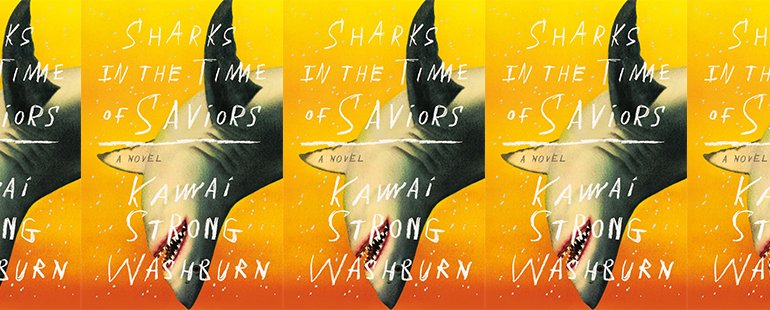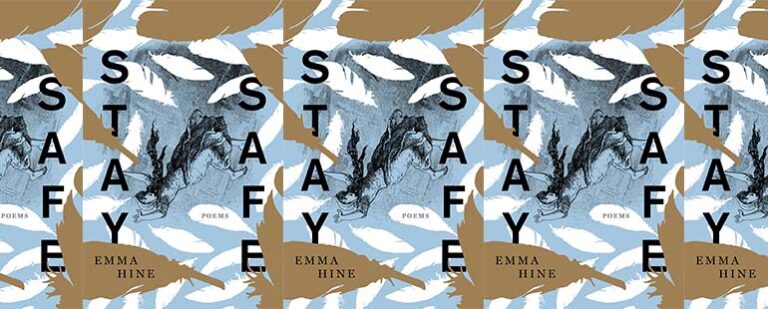“One of the things I love most about literature is the possibility of inhabiting someone else’s consciousness”: An Interview with Kawai Strong Washburn

Life is not in our grasp. It wanders. It meanders. It does what it wants, leaving us to fight back as best we can and carry forward once the devastation ebbs. There is no way to map its future, to quantify the forthcoming, to garner assurances. Kawai Strong Washburn’s debut novel Sharks in the Time of Saviors weaves this rattling existentialism through the lives of three siblings and the islands of Hawai’i, up and down the Pacific Coast, and over years of his characters’ individual and collective struggles as they each await the arrival of a miracle promised in their youth but never fully materializing—a shark circling the waters.
Sharks in the Time of Saviors opens with Nainoa Flores falling overboard off the coast of Hawai’i. He is seven years old. His mother Malia goes into the water to save him, but it isn’t necessary—a shiver of sharks has come to the aid of young Noa, delivering him back to the boat somehow unharmed and now marked with the stuff of legends: the boy who was saved by sharks. As his mother Malia describes it, “The water where you were was all churn. The shapes of the sharks were thrashing, diving, rising, something like a dance.”
Five years later, the novel shows us Noa beginning to learn the new powers evolving within him. At a party one summer, he uses his touch to heal the grievous wound of a mate, and, shortly thereafter, quiet throngs of people begin knocking at the door of his family’s Hawai’i home, everyone seeking healing of some kind or another. Like a miracle-worker, Noa lays hands on those with maladies and they leave the family’s house feeling wonderfully fixed. This too has the effect of turning Noa’s family away from the precipice of poverty one brief and unseen session at a time.
But, such is life: nothing is predictable, and soon Noa’s energy is spent, his spiritual powers requiring a recharge. While he is left to rest in solitude, the family is pushed back into its previous financial precarity. With barely enough to get by, his older brother, Dean, decides to focus on the possibility of a career in the NBA, and his younger sister, Kaui, becomes hopeful at the prospect of turning her eager and pragmatic mind into a meaningful and stable job.
Even this more normal trajectory, though, cannot proceed without predicament. Soon enough, all three children are forced into living out their young adulthood on the mainland. Dean ends up in Spokane, fighting for his basketball dreams as they slide into oblivion. Kaui gets to San Diego, where she struggles to maintain her academic workload alongside her new freedoms. And Noa has gone to work with an ambulance crew in Portland, keeping his powers to heal mostly hidden. He lays his hands on patients when he believes no one is watching, focusing his energy on fixing them, but while this has some vague effect, his powers won’t do exactly what he wishes. They feel like they are perpetually diminishing, as if soon they will have no effect at all.
Across four sections, one for each sibling and the brood’s mother, Washburn tells this story of a family slipping apart, colliding with the rest of the world, hoping for the fulfillment of their hopes and dreams. This structure allows him to exercise four distinct viewpoints across an expanse of years. He does so with flourish and grace: Dean’s speaking pattern has a rough and hand-hewn edge—“I never felt the gods Mom was always talking about, but I did feel something right then when he said that, and for a while after. I got lifted”—whereas Kaui narrates with far more poetic precision: “But mostly it was time like a dull buzz. Routine and sunup sundown hello goodbye. Time like a filament made incandescent by a weak electric current.” Their mother, Malia, keeps the past alive through reminiscence and nostalgia, remembering of young Noa, “The last cairn before we reached the trees was topped with a half-buried plastic robot, something you had built in one of your incredible science classes at Kahena,” while Noa himself spends time trying to unearth the philosophical meanings behind his powers: “And something deeper, the trembling understanding of what I was becoming capable of.” This split narration keeps the novel moving evenly while interjecting facets of the whole family’s struggle across time and distance.
Washburn also grounds Sharks in the Time of Saviors in the native Hawaiian language, without appendix or apology. “Some nights I’d split sides of the couch with one of my dull roommates, the kind of haole girls that were up-and-coming members of the Future Trophy Wives of America,” Kaui says. “Bland as saimin without sauce.” The Hawaiian words are included without italics or definition, refusing to be reduced for easy ingestion. The effect of this decision is that non-native Hawaiians feel a connection to the characters, like how the Flores family is connected to the island—the reader, by extension of language, is part of the family.
The Flores siblings, as well as their mother, Malia, and their father, Augie, are deeply connected to the land itself—both the water and the islands. Throughout the novel, Washburn brings the siblings to and from the island like a tide, the pull always too great to let the children go. Even as each goes their separate way and conflicts mount between them, the tide crashes like a signal, calling them back to home. Washburn artfully meditates on how the land defines human beings, how we are a part of it no matter the distance we roam, no matter the sharks we have encountered. And what will become of this world, and of us, if we continue to take that connection for granted, if we continue to forsake the land around us? As Noa sees it, thirteen years later, “The sun is just barely risen, and I can see four lashing shadows in the water, headed directly for me, slowing to a liquid glide as they close the distance. They are sharks, and for a moment my body shoots with fear, I should go, I should go, there’s still time, but another part of me is done with fleeing, and that part of me makes a stand. I tread water gently, and the sharks begin to circle.”
I recently spoke with Washburn about these ideas—the unpredictability of life, his use of varied character perspective and unapologetic inclusion of Hawaiian language, and the relationship humans have to the land around us—as well as what’s next for his writing career.
J.A. Tyler: We’re seeing it now more than ever: life is unpredictable. And life for the Flores family is too, seemingly at every turn. Was this a calculated move, to create upheaval whenever characters started getting settled or did it happen organically as you wrote their stories?
Kawai Strong Washburn: The upheaval was a calculated move, although it was motivated primarily by the circumstances of the characters’ lives. I was conscious of what poverty can feel like to those living within it. Poverty is nothing if not a constant state of threat, a constant state of upheaval. Some of us are feeling those things for the first time, I think, when grappling with the ramifications of climate change, or the [COVID-19] pandemic: “Is there any way I can protect my loved ones? What happens if I can’t get any food tomorrow?” But that’s a daily reality for many people in the United States, whether an undocumented immigrant, a person of color, or anyone living in poverty here—or around the world. It’s what the characters, and I hope the reader, live through in this story.
Also, as a writer, I’m always worried about the terminal illness of boring the reader, and some of the upheaval is also probably a function of that. Boredom is what’s most likely to make me put down a book. That has little to do with stakes, though, or upheaval; plenty of genre literature, like a Marvel superhero movie, has a million things “happening,” lots of upheaval, but nothing of true consequence.
J. A. Tyler: This novel almost seems like a reversal, like the saving of Noa in the beginning is the start of the family’s collapse. Was Noa’s rescue the kernel for the book?
KSW: It began with that image, a child being rescued from drowning by sharks. I worked it over in my subconscious for quite a while before even thinking it was something worth writing about. When I did, I realized there was a risk it would become some sort of messianic story, one that blithely accepts easy answers and privileges some singular character (usually a white male) with heroism. So the story then largely became an exercise in trying to defeat that. Americans and modern “western” culture seem so fixated on singular hero narratives, from the Bible to Harry Potter, where the salvation is the crescendo. If I wanted to invert that narrative, or place it against what I think really happens in the world, starting at that crescendo and then wondering what would happen if it were false, seemed like a good way to go about it.
JAT: The three siblings and their mother, Malia basically, share equal airtime in the novel, and this technique makes the book move nicely, flow easily. Was that part of the goal in your decision to using varied perspectives? Why else were you drawn to parceling up the novel’s voices in this way?
KSW: One of the things I love most about literature is the possibility of inhabiting someone else’s consciousness. People talk a lot about augmented/virtual reality as a new frontier in technology, but we’ve had it for thousands of years in the book. First-person narrative is one of the best ways to achieve that, and it can be particularly rich as a rotating perspective among closely intertwined characters. Everything everyone says or does can be reflected back in a way that allows the reader to participate in the story on so many levels, because they’re experiencing each character from both sides. Since this is a family saga, it seemed the most appropriate—and, honestly, attractive—way to give the story more depth and nuance.
JAT: Without spoiling anything for the reader, one perspective we don’t get until nearly the end is the voice of the father, Augie. Why did you choose to hold his voice off for so long, and then to keep it in such narrow confinement?
KSW: I didn’t want to saturate the readers’ attention, for one thing. Adding another voice would make for an even longer book (or else a shallower one). More importantly, I wanted to preserve the mystery of Augie’s experience until the end, because it holds the key to understanding what Nainoa was (and wasn’t)—or, at least, it presents that to readers in a way that allows them to interpret it all for themselves as fully as possible. Also, a rendering of Augie’s mind (especially in the middle and late third of the book) would have been very confusing and jarring to most readers.
JAT: While the characters each have distinct voices, the novel as a whole also exercises the slang and language of Hawaiian culture, but it does so without an appendix of definitions or over-contextualization. Was this intended to further immerse a reader in the world of these characters, to help us live through their broader context?
KSW: Yes, exactly. Because the novel is written in first-person perspectives, it would’ve rung false to have the characters themselves make meta-commentary on their slang in order to convey information to the reader. Similarly, setting the slang and loan words from other languages in italics would have suggested, at some level, that the words were “foreign,” which they are not, neither to those characters nor to me or many people living in Hawai’i. Filipino, Japanese, Chinese, Portuguese, Hawaiian—all the languages of the islands have mixed-use words that show up in casual conversation, and no one blinks an eye. The best way to have the reader experience that was to write it the way it feels: no italics, no glossary, nothing foreign.
But really, an appendix, italics, meta-commentary/footnotes—it all assumes a certain reader is the default, which is unacceptable to me. Who’s to say the default reader isn’t someone from the islands that would know all the slang and references? I can’t tell you the number of books in the English language I’ve read that make reference to all sorts of things, from legal terms to sporting events to pop-culture, that I’ve never encountered. And yet I think a lot of people would consider those references self-evident, because of the easy blindness that comes from living in a cultural majority. When I encounter words like that as a reader, if I don’t feel capable of intuiting the definition, and the word matters enough for my understanding, then I go and look it up. It still happens to me all the time, whether it’s Shakespeare or millennial slang or [something] Southern Gothic.
Books are always some form of exchange. They require varying levels of work, from the writer and the reader. If the reader isn’t up for doing any work, there’s nothing wrong with that, and there are plenty of books out there which are more than happy to serve that desire.
JAT: On another note, landscape plays a major role in the characters’ lives as they inhabit Hawai’i as well as Pacific Coast cities, but landscape also seems to inhabit the characters themselves. What is so significant for you as a writer, or for this novel, in our synergy with the physical world?
KSW: Human beings are a part of the natural world, not above it. I’ve felt this myself while surfing, skin diving, rock climbing, kayaking, and backpacking, among other “outdoor” endeavors. Human experience can reach an incomparably rich octave in the midst of natural environments. We do not, as is often suggested, have dominion over the flora and fauna, but rather a symbiotic bond. The first people of this world (for all the other ways in which they were far from perfect) understood that, because they were incapable of putting enough barriers between themselves and the natural world to be convinced otherwise. This is one of the themes of the novel, because it’s the defining challenge of the twenty-first century: are we going to alter our relationship with the natural world enough to avoid annihilating ourselves? The universe will go on without us if we don’t. I’d rather humans exist in the world, but the choice is up to us.
JAT: What are you reading right now? What recent books have you loved (or are loving)?
KSW: I’m about to start a galley of K-Ming Chang’s Bestiary as well as (recently released) Simon Jimenez’s The Vanished Birds. Plus I’m in the middle of Danez Smith’s Homie (which is excellent), and absolutely loved Edgar Kunz’s Tap Out.
JAT: What’s next for you? What are you working on now or looking forward to starting soon?
KSW: I’ve started work on a new novel. It spans over three hundred years in Hawai’i (from the 1800s to the twenty-second century) and includes feudal chieftain battles, matriarchal dynasties, climate change, future tech, genetic programming and neural transmitters, a band of female pirates, benevolent corporations (seriously), and Buddhist influences. It probably sounds frenetic, but it’s not. There’s a lot of internality and themes of the human condition and all that. You know, all the stuff “big L” literature (and I) aspire toward. It just happens to also have pirates. I’m excited to see what it becomes.


